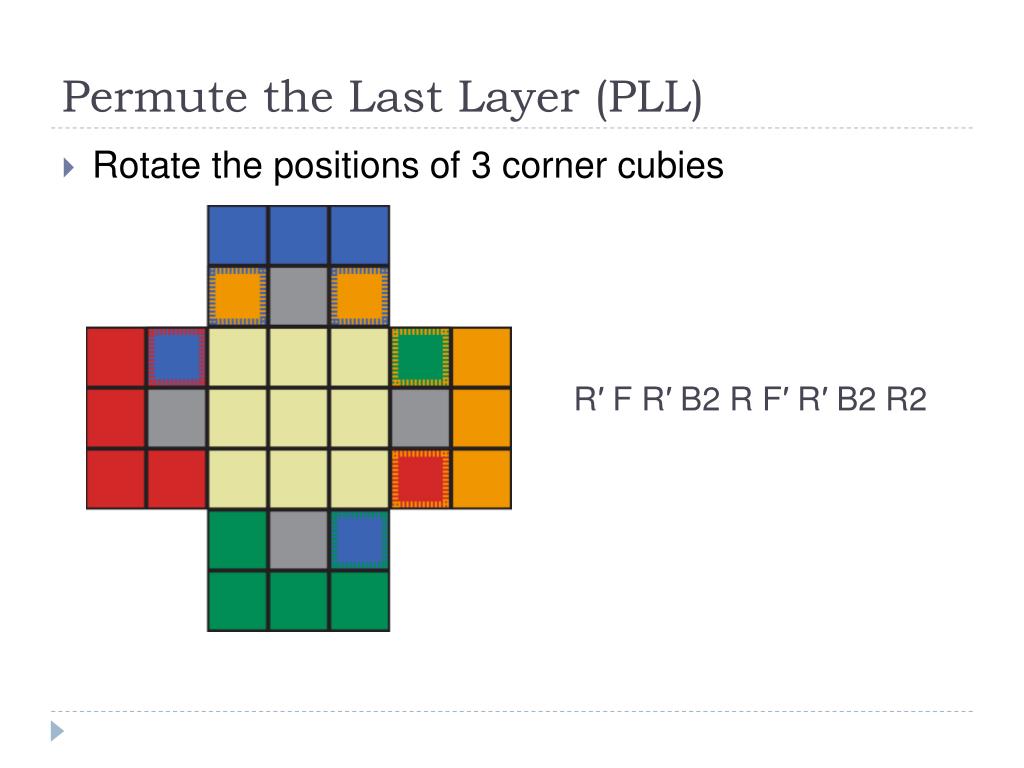

These will directly take you to a solved cube position. Follow the arrows on the image to know when to apply which algorithm. Both need to be used only when four unsolved corners are present. Okay, here are the last algorithms for this tutorial (pretty easy ones!). Now, lets learn to solve these cases in one shot. For some positions, there are several algorithms, all doing. Then the leftmost k n m elements of p form a 132-optimal. You may have four edges that need to be solved too! In such cases you follow the 3-edge algorithms right? And then you follow the same algorithm again. The graphics show the top view of the last unsolved layer (the U side). PROPOSITION 5.36 Let p be a layered 132-optimal n-permutation whose last layer is of length m. See how the color of each sticker of the corner matches the color of the center that sticker is on Now you will have one of the two states below. To the right is an example of a corner in the correct place. Now, we just discussed clockwise and counter-clockwise cases. Turn the top layer until exactly two of the corners are in their correct place. You then get any of the following right?Īs in the beginner method, we solve counter-clockwise case using, F2U’M’U2MU’F2 and the clockwise case using F2UM’U2MUF2. Final EdgesĪfter the corners are fixed, few edges remain at the end. If you don't want to learn them all, you may find it useful to learn only the 7 cases in Table 5.10 combined with the permutation of the last layer ( PLL ).

Instead, only apply one algorithm and save your time. Now, you no longer need to repeat the same algorithm again. We are proud to list acronym of PLL in the largest database of abbreviations and. So the first algorithm orients all the last layer pieces (makes.
PERMUTE LAST LAYER DOWNLOAD
However, if you aren’t comfortable with this algorithm, then you can always download Algorithms Lite and try some more. Looking for general definition of PLL The PLL means Permute Last Layer. These steps are solved using only one algorithm each. When there are diagonally correct corners (the image above), then place one correct corner on your front right and the other on your back left.Then, follow this algorithm and you will find that your corners are solved in one go. This algorithm may “look” a bit complex, but if you try it on your cube, you’ll find that it’s very easy, specially the first few steps. Here is one algorithm I found which is very easy to memorize and I still use it: Corner Permutation of the Last Layer, abbrevaited CPLL, permutes the corners of the last layer without affecting anything else. Well, if you have seen my post on Rubik’s cube softwares and have tried the Algorithms Lite app, then you must have seen many algorithms for this case but not all of them are easy to remember. But applying this same algorithm once takes a long time (twice will take even longer), so we need to find an algorithm that can do this all at once. What do you do then? You use that same algorithm twice. Now there are times when the correct corners are placed like this: Which algorithm do you use for solving this situation? Right, you use R’FR’B2RF’R’B2R2U and the correct corners are at the back of the cube. There are 27 PLL algorithms, but we need to. There are always two corners correctly positioned in this situation. This is the final part of the beginners guide where you will learn to permutate the last layer to finish the cube. What do we do first once we reach this state in the beginners method? Correct, we first align the corners here. Permutation of last layer (PLL) is when you solve this unsolved part of the cube: The correct letter to turn the bottom side is 'D.' ('D' stands for "down.NOTE: Before proceeding make sure you have learnt advanced Rubik’s cube notations or you can learn them here. Note:Remember that 'B2' is to turn the BACK side twice, not the bottom. (Actually for state 2, the algorithm would still work if the two correct corners were at the top-left and bottom-right instead.)

Therefore, the two correct corners in State 1 are the two on the right side, and the two correct corners in State 2 are the bottom-left and top-right ones.

The corners that need to be swapped have arrows pointing to them. Either the two correct corners are adjacent to each other (and therefore the two that need to be swapped are adjacent too), or the two correct corners are diagonal from each other (and the two that need to be swapped are diagonal too). Now you will have one of the two states below. See how the color of each sticker of the corner matches the color of the center that sticker is on? Turn the top layer until exactly two of the corners are in their correct place. Rubik's Cube for Beginners Step 6: Permute Last Layer Corners


 0 kommentar(er)
0 kommentar(er)
